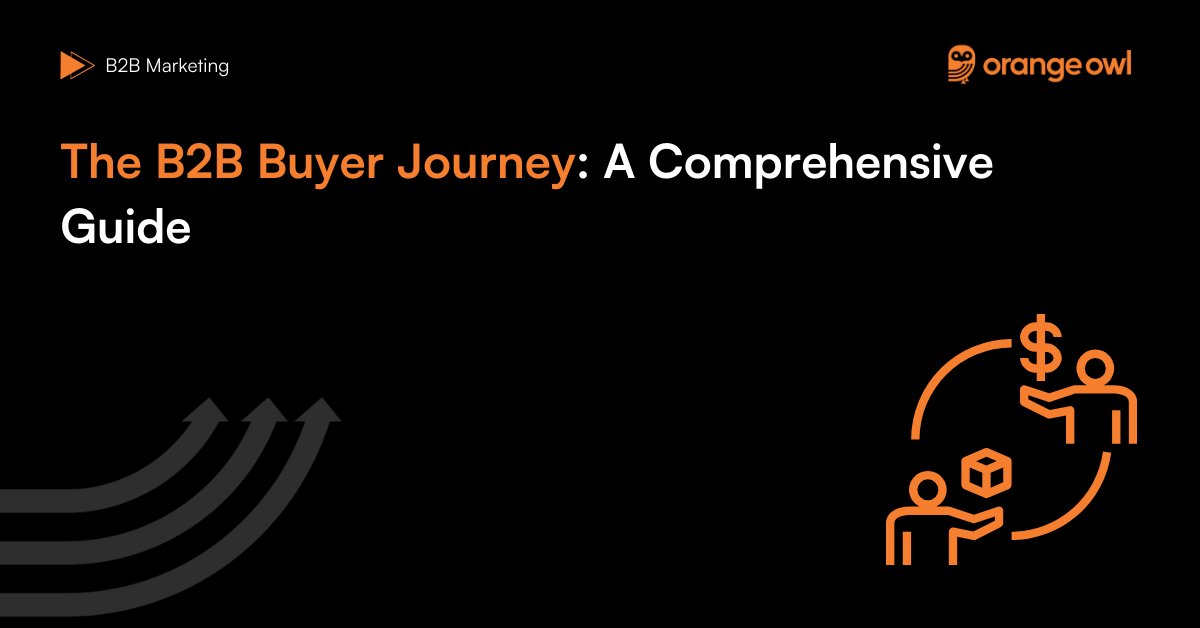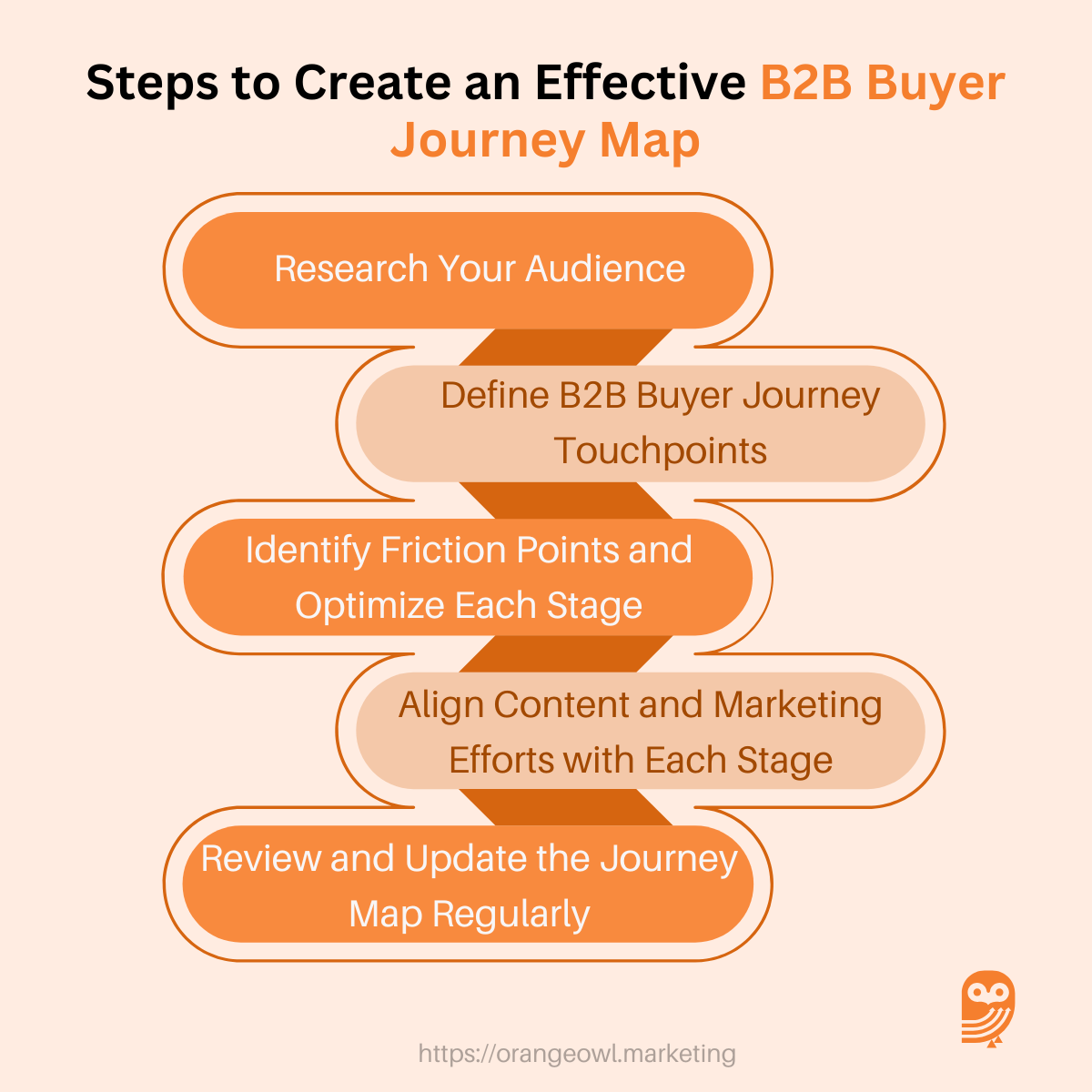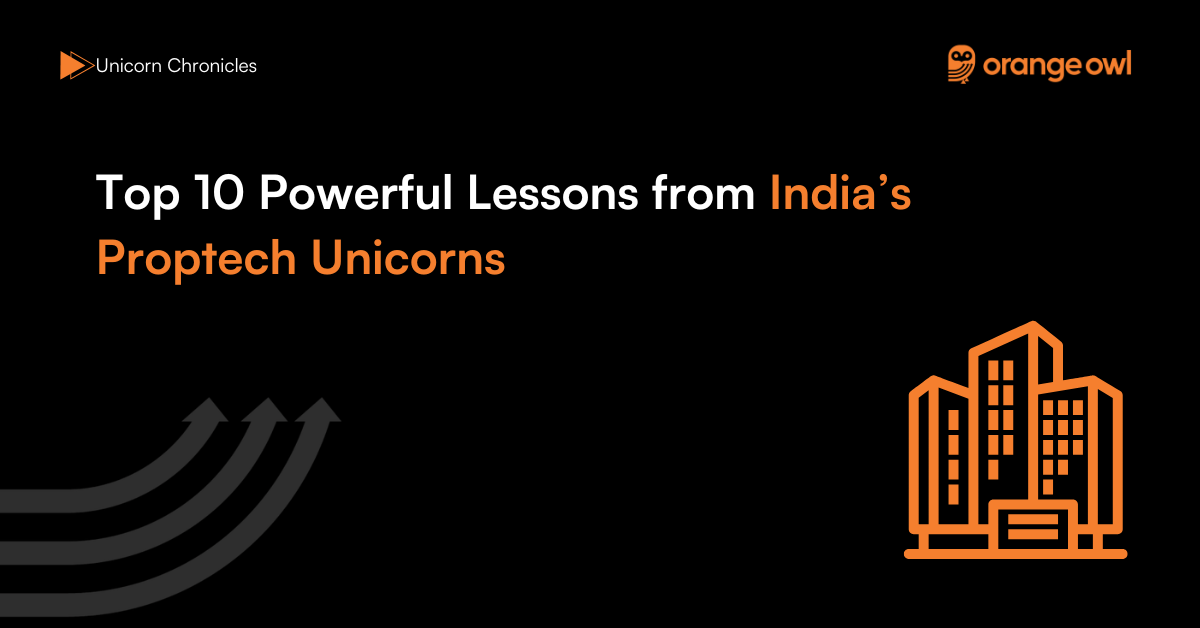The B2B Buyer Journey: A Comprehensive Guide
Orange Owl
March 8, 2025

Table of Contents
Introduction
Understanding the buyer journey is crucial in B2B marketing. Unlike B2C transactions, which are often impulsive, B2B purchasing decisions involve multiple stakeholders, longer sales cycles, and require a well-thought-out approach. A strategic understanding of the buyer journey helps marketers create targeted campaigns, personalize interactions, and ultimately drive conversions. This guide delves deep into the B2B buyer journey, its stages, challenges, common mistakes, and strategies to optimize each phase.
What is the B2B Buyer Journey?
The buyer journey is the process a potential customer goes through from the moment they recognize a problem to the final purchase and beyond. It consists of several stages, including awareness, consideration, decision, and post-purchase engagement. In B2B, this journey is more complex, involving multiple stakeholders, thorough research, and a longer decision-making process. Understanding the buyer journey allows businesses to create targeted marketing and sales strategies that align with customer needs at each stage.
Stages of the B2B Buyer Journey and Strategies for Each Stage
- Awareness: The buyer realizes they have a problem and starts researching potential solutions. Content such as blog posts, whitepapers, and educational webinars help inform prospects at this stage.
Strategy: Utilize inbound marketing tactics such as SEO, content marketing, and social media to increase brand visibility. Offer educational content that addresses common pain points and industry challenges. - Consideration: The buyer evaluates different options, comparing vendors, pricing, and product features. Case studies, comparison guides, and product demos play a critical role in shaping decisions.
Strategy: Leverage email marketing, retargeting ads, and personalized product recommendations. Offer free trials, detailed case studies, and interactive demos to help prospects assess the value of your solution. - Decision: The buyer selects a vendor and finalizes the purchase. This stage involves negotiations, contract discussions, and final approvals. Strong sales enablement materials and a seamless purchasing process help close deals faster.
Strategy: Ensure a smooth sales process by providing transparent pricing, flexible contract options, and dedicated sales support. Use customer testimonials and third-party validation to reinforce trust. - Post-Purchase Engagement: The buyer evaluates the product, seeks support, and considers future engagements. Continuous communication, customer support, and loyalty programs help ensure long-term satisfaction and retention.
Strategy: Implement a strong customer success program with proactive support, onboarding resources, and feedback collection. Engage customers through loyalty programs, exclusive webinars, and community-building initiatives.
Importance of the B2B Buyer Journey
When buyers arrive for a product demo, they’ve already done their research, compared you to your competitors, and read extensive customer reviews.B2B buyer journey statistics support this claim. Sirius Decisions reports that buyers now complete 67% of their journey digitally.
What does this plethora of online info mean for your sales team?It means that it’s very easy for buyers to collect information independently, and your outbound sales reps have fewer opportunities to influence their decisions.
The typical buying group for a complex B2B solution involves 6-10 decision-makers, each armed with 4-5 pieces of information they’ve gathered independently.At the same time, buying groups have more options and solutions to consider; new B2B technologies, products, and services emerge every year. These factors make it increasingly difficult for customers to make purchases. More than three-quarters of Gartner-surveyed customers described their purchase as complex or challenging.
Understanding the B2B customer journey is crucial to solving this problem and smoothing your B2B sales process. Once your reps know who your buyers are, what they’re looking for, and where they’re looking, they’ll be able to:
- Improve the buyer experience.
- Build value for your product or service.
- Increase win rates.
- Move prospects quickly through the sales funnel.
Steps to Create an Effective B2B Buyer Journey Map
Research Your Audience: Your B2B buyer journey map should be based on real customer data, not assumptions.
- Talk to your sales team: They interact with prospects daily and can provide insights into common objections, buying triggers, and deal breakers.
- Survey existing customers: Ask them how they discovered your company, what influenced their decision, and what nearly stopped them from purchasing.
- Analyze behavioral data: Use Google Analytics, heat maps like Hotjar, and CRM reports to track how visitors interact with your site and where they drop off.
- Conduct social listening: Monitor LinkedIn discussions, industry forums, and reviews to understand what buyers say about their challenges and competitors.
At the end of this step, you should have a clear buyer persona—a representation of your ideal customer, including demographic, personal, and behavioral data influencing pain points, motivations, and decisions. If you’re in B2B SaaS, include technographic data.
2. Define B2B Buyer Journey Touchpoints: Identify where and how buyers interact with your brand throughout their journey, such as through your website, social media, or direct sales engagements.
- Stage one: The buyer realizes they have a problem. Touchpoints include blog posts, SEO searches, social media, and industry reports.
- Stage two: The buyer actively looks for solutions and evaluates different vendors. Touchpoints include webinars, product comparison sheets, and case studies.
- Stage three: The buyer finalizes their choice and selects a vendor. Touchpoints include sales calls, product demos, free trials, and contract negotiations.
Don’t forget the post-sale stage. Nurturing customers after purchase improves retention, upselling, and referrals.

3. Identify Friction Points and Optimize Each Stage: Think of your buyer’s journey as a process with smooth steps and challenges. The key is to minimize friction wherever possible.
- High bounce rates on landing pages? Your messaging might not be clear or relevant.
- Customers dropping off after requesting a demo? Maybe they didn’t receive a follow-up fast enough.
- Decision-makers not converting? You might need more substantial proof of ROI.
Use heat maps, A/B testing, and conversion tracking to optimize friction points and create a seamless journey across your SaaS sales funnel.
4. Align Content and Marketing Efforts with Each Stage: Each stage of the B2B purchase journey requires different types of content.
- Top of the funnel (Awareness): Educational blogs, whitepapers, and infographics.
- Middle of the funnel (Consideration): Webinars, case studies, ROI calculators.
- Bottom of the funnel (Decision): Demos, free trials, competitor comparisons.
Use automated workflows, email sequences, and retargeting ads to ensure your marketing and paid teams deliver the right content at the right time.
5. Review and Update the Journey Map Regularly: The buyer journey constantly evolves—new market trends, emerging competitors, and shifting customer behaviours can change how buyers interact with you. Continuously collect data using real-time analytics and sales feedback to refine your journey map, ensuring it remains accurate and effective.
The Customer Journey in B2B Marketing
The customer journey is closely linked to the buyer journey but extends beyond the initial purchase, focusing on long-term relationships and brand loyalty. The key stages include:
Discovery & Engagement – The prospect becomes aware of your brand through marketing efforts.
Evaluation & Purchase Decision – The customer weighs different options and finalizes a vendor.
Onboarding & Adoption – Post-purchase, businesses must ensure a seamless onboarding experience.
Retention & Expansion – Providing excellent service ensures repeat business and upsell opportunities.
Advocacy – Satisfied customers become brand advocates, referring new clients and leaving positive reviews.
How Does the B2B Customer Journey Differ from B2C?
While both B2B and business-to-consumer (B2C) journeys aim to convert prospects into customers, key distinctions include:
- You sell to teams, not individuals: B2B purchases usually involve multiple stakeholders, from end-users to procurement and C-suite executives. Convincing one person isn’t enough—you need to win over an entire team. In contrast, B2C decisions are often made by individuals and can be more spontaneous.
- The sales cycles are longer: The B2B sales cycle is generally longer, reflecting the complexity and higher stakes of business purchases compared to the often shorter B2C cycle. The average B2B buying cycle is 6-12 months longer than the B2C customer journey.
- The deal sizes are bigger: B2B transactions are typically larger both in terms of deal/order size and total revenue per customer. Deals take developing longer but often generate more revenue per sale than B2C transactions.
- You need more content assets: B2B purchases involve significant investments, meaning due diligence is extensive. You need a structured marketing approach with content spread across multiple stages to educate decision-makers and drive conversions.
- B2B is more emotional than you think: Contrary to popular belief, B2B decision-making isn’t purely logical. Studies show B2B customers are significantly more emotionally connected to their vendors than B2C customers. Decisions often go beyond pricing and features, focusing on trust, long-term relationships, and perceived fit with their business needs.
Common Mistakes in the B2B Buyer Journey
- Ignoring Buyer Personas: Not understanding your audience leads to ineffective marketing.
- Lack of Personalization: Generic messaging fails to engage buyers.
- Overcomplicated Processes: A lengthy sales cycle discourages potential customers.
- Inadequate Post-Purchase Support: Poor customer experience leads to churn.
- Neglecting Data Analytics: Failing to track buyer behavior and adjust strategies accordingly.
- Weak Content Strategy: Not providing relevant content for each stage of the journey can lose potential leads.
- Failure to Align Sales and Marketing: When sales and marketing teams are not synchronized, leads may be lost or mismanaged.
- Ignoring Digital Engagement: Not leveraging automation, AI, or digital platforms can make your brand less visible to potential buyers.
Conclusion
The B2B buyer journey is a multi-stage process that requires strategic planning, targeted content, and continuous engagement. By understanding each phase and avoiding common mistakes, businesses can improve lead generation, conversion rates, and long-term customer retention. Companies that invest in AI-driven analytics, marketing automation, and hyper-personalization will gain a competitive edge by delivering the right message at the right time. Adapting to evolving buyer behaviors and optimizing every stage of the journey will ensure sustainable growth and success in the B2B market. Staying ahead in B2B marketing requires businesses to be agile, customer-centric, and data-driven in their approach.
Frequently Asked Questions(FAQs) on B2B Buyer Journey
The main goal of mapping the B2B buyer journey is to understand the different stages a potential customer goes through before making a purchase. By identifying these stages, businesses can create targeted strategies to engage buyers, address pain points, and optimize marketing and sales efforts. A well-mapped buyer journey helps improve customer experience, increase conversion rates, and build long-term relationships.
Company size plays a significant role in how purchasing decisions are made. Larger enterprises often have multiple stakeholders involved in decision-making, leading to longer sales cycles and more complex approval processes. These companies also conduct extensive research, require detailed proposals, and may have strict procurement policies. On the other hand, smaller businesses tend to have a shorter decision-making process with fewer approvals, allowing them to move faster through the buying journey.
Although B2B decisions are heavily driven by logic, data, and ROI, emotions still play a crucial role. Buyers want to work with companies they trust and feel confident about. Factors like brand credibility, positive customer experiences, and personalized engagement influence purchasing decisions. Even in a professional setting, emotions such as fear of making the wrong choice or excitement about a promising solution can impact decision-making.
To accelerate the B2B sales cycle, businesses should:
- Offer clear and transparent pricing to avoid delays in negotiations.
- Automate lead nurturing through email sequences and chatbots.
- Provide easily accessible product information and case studies.
- Use AI-driven insights to personalize outreach.
- Streamline the approval process by identifying key decision-makers early.
- Address objections proactively to prevent delays.
By implementing these strategies, businesses can reduce friction and close deals faster.
Competitor analysis helps businesses understand industry trends, customer expectations, and gaps in the market. By analyzing competitors’ strengths and weaknesses, companies can differentiate their offerings, refine their value propositions, and highlight unique selling points. Additionally, monitoring competitors’ customer reviews and feedback allows businesses to identify common pain points and position their products as superior alternatives
B2B buyers rely on a mix of content formats to make informed decisions. These include:
- Whitepapers and research reports for in-depth industry insights.
- Case studies showcasing real-world applications of products or services.
- Product demos and webinars to understand features and functionality.
- Peer reviews and testimonials to validate credibility.
- Comparison guides to evaluate options side by side.
Businesses should offer a combination of these content types to cater to different buyer preferences and stages of the journey.
Digital transformation has significantly changed how B2B buyers research, evaluate, and purchase products. With the rise of AI-driven chatbots, automated email marketing, and self-service portals, buyers now expect a seamless, personalized experience. Digital tools also allow businesses to track customer interactions, gain data-driven insights, and improve engagement. Companies that fail to adopt digital strategies risk falling behind competitors that leverage technology to enhance the buyer journey.
Post-purchase engagement plays a critical role in customer retention and repeat business. When companies provide strong customer support, proactive communication, and ongoing value through educational content or loyalty programs, they build trust and long-term relationships. Satisfied customers are more likely to renew contracts, upgrade services, and refer others. On the other hand, neglecting post-purchase engagement can lead to churn and lost revenue opportunities.
Some of the biggest challenges businesses encounter when analyzing their buyer journey include:
- Difficulty tracking multiple customer touchpoints across different channels.
- Aligning sales and marketing teams to ensure a cohesive approach.
- Keeping up with changing buyer behaviors and industry trends.
- Accurately measuring the effectiveness of different marketing strategies.
- Personalizing the buyer journey without overwhelming prospects.
Addressing these challenges requires continuous data analysis, cross-team collaboration, and a customer-centric approach.
Personalization is key to improving the B2B buyer experience. Businesses can achieve this by:
- Using CRM and AI tools to segment audiences based on behavior and preferences.
- Delivering tailored content recommendations through email and website interactions.
- Offering personalized demos and consultations based on customer needs.
- Engaging with prospects on their preferred communication channels.
- Providing customized pricing options and solutions that fit specific business requirements.
By leveraging data and technology, B2B companies can create a more relevant and engaging buyer journey that drives conversions.


